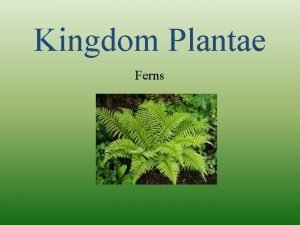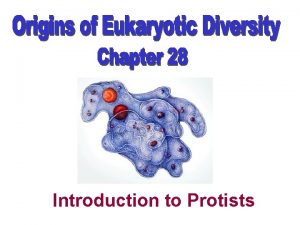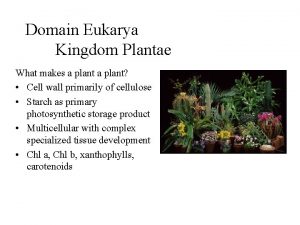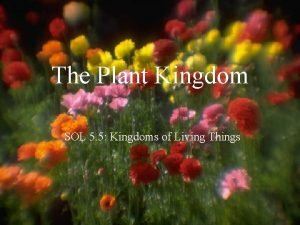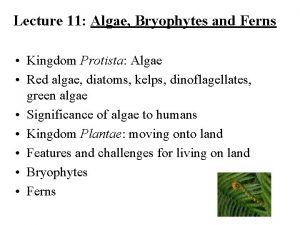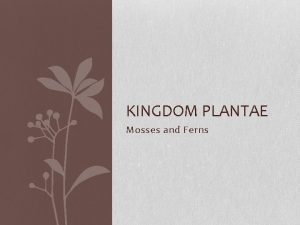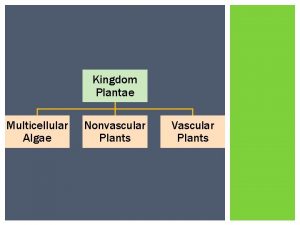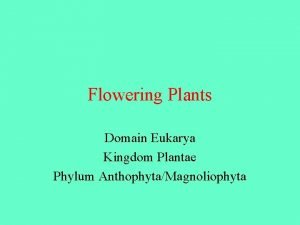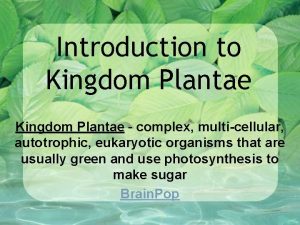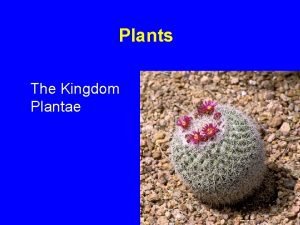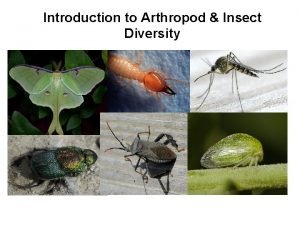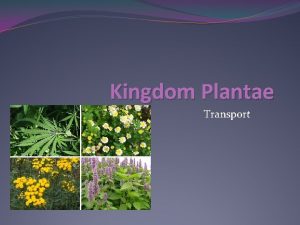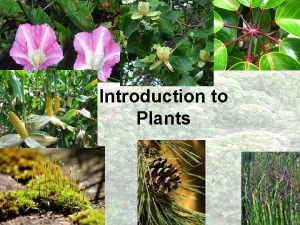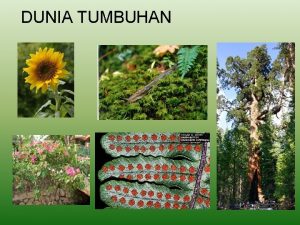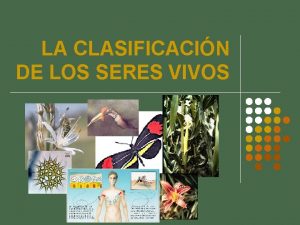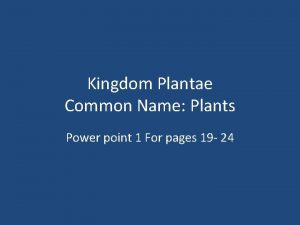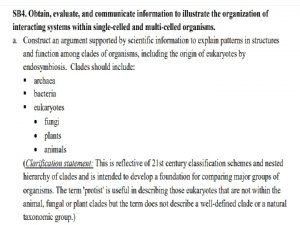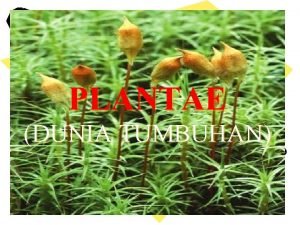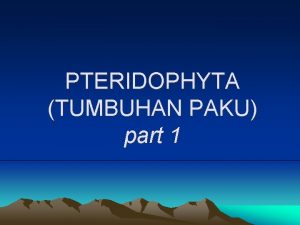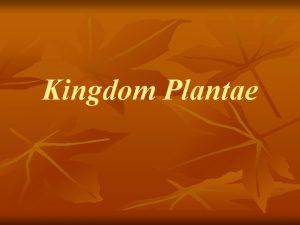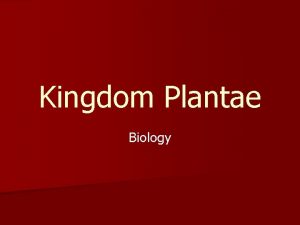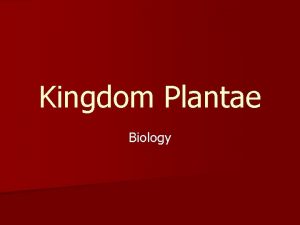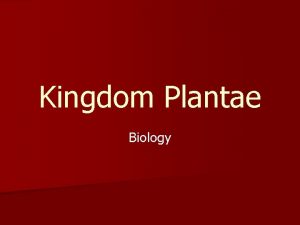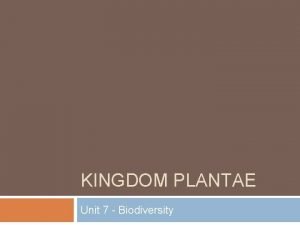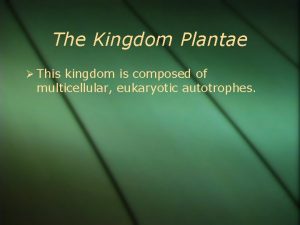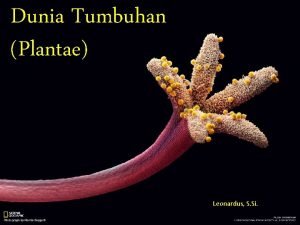KINGDOM PLANTAE dr aarif dr aarif dr aarif








































- Slides: 40

KINGDOM PLANTAE dr. aarif

dr. aarif

dr. aarif

ALGAE Algae are mostly aquatic, some being terrestrial also. A few algae grow on other plants. Aquatic algae grow in marine water or fresh water They may be small, unicellular, microscopic like Chlorella (non-motile), Chlamydomonas (motile) or multicellular unbranched filamentous like Spirogyra and Ulothrix, or branched filamentous like Chara or colonial forms like Volvox or huge macro scopicsuch as sea weeds which measure more than 60 meters in length. e. g. Sargassum dr. aarif

The algal cell wall consists of two layers i. e. inner cellulosic and outer composed of pectin. The algae consist of various types of photosynthetic pigments. Chlorophyll-a is an(essential pigment) Carotenoids Phycobilins. The reserve food material is in the form of starch, laminarin , starch, mannitol or floridean-starch, etc. dr. aarif

REPRODUCTION IN ALGAE Reproduction Vegetative Fragmentation (in filamentous forms) and cell division (in unicellular forms). Asexual By the formation of various types of nonmotile or motile spores. The most common being the zoospores. They are flagellated (motile) and on germination gives rise to new plants. Sexual formation and fusion of gametes. Isogamy : fusing gametes are same Anisogamy : fusing gametes are different Oogamy : fusing gametes are totally different, enough to be called as male and female gametes dr. aarif

dr. aarif

At least a half of the total carbon dioxide fixation on earth is carried out by algae through photosynthesis Being photosynthetic they increase the level of dissolved oxygen in their immediate environment. They are of paramount importance as primary producers of energy-rich compounds which form the basis of the food cycles of all aquatic animals. Many species of Porphyra, Laminaria and Sargassumare among the 70 species of marine algae used as food. Certain marine brown and red algae produce large amounts of hydrocolloids (water holding substances), e. g. , algin(brown algae) and carrageen (red algae) are used commercially Agar, one of the commercial products obtained from Gelidium and Gracilaria are used to grow microbes and in preparations of ice-creams and jellies. Chlorella and Spirullina are unicellular algae, rich in proteins and are used as food supplements. dr. aarif

ALGAE Chlorophyceae (green algae) Phaeophyceae (brown algae) Rhodophyceae (red algae) They are usually grass green due to the dominance of pigments chlorophyll a and b. The pigments are localised in definite chloroplasts. The chloroplasts are of different shapes; discoid, plate-like, reticulate, cup-shaped, spiral or ribbon-shaped in different species. Most of the members have one or more storage bodies called pyrenoids located in the chloroplasts. Pyrenoids contain protein besides starch. Some algae may store food in the form of oil droplets. Green algae usually have a rigid cell wall made of an inner layer of cellulose and an outer layer of pectose. Vegetative reproduction usually takes place by fragmentation or by formation of different types of spores. Asexual reproduction is by flagellated zoospores produced in zoosporangia. The sexual reproduction shows considerable variation in the type and formation of sex cells and it may be isogamous, anisogamous or oogamous. The common forms are Ectocarpus, Dictyota, Laminaria, Sargassumand Fucus. dr. aarif

ALGAE Chlorophyceae (green algae) Phaeophyceae (brown algae) Rhodophyceae (red algae) The members of phaeophyceae or brown algaeare found primarily in marine habitats. They show great variation in size and form. They range from simple branched, filamentous forms [Ectocarpus] to profusely branched forms as represented by kelps, which may reach a height of 100 metres. They possess chlorophyll a, c, carotenes and xanthophylls, They vary in colour from olive green to various shades of brown depending upon the amount of the xanthophyll pigment, fucoxanthin present in them. Food is stored as complex carbohydrates, which may be in the of laminarin or mannitol. The vegetative cells have a cellulosic wall dually covered on the outside by a gelatinous coating of algin Vegetative reproduction takes place by fragmentation. Asexual reproduction in most brown algae is by biflagellate zoospores that are pearshaped and have two unequal laterally attached flagella. Sexual reproduction may be isogamous, anisogamous or oogamous. The common forms are Ectocarpus, Dictyota, Laminaria, Sargassumand Fucus. dr. aarif

ALGAE Chlorophyceae (green algae) Phaeophyceae (brown algae) Rhodophyceae (red algae) The members of rhodophyceae are commonly called red algaebecause of the predominance of the red pigment, r phycoerythrin in their body. Majority of the red algae are marine with greater concentrations found in the warmer areas. The red thalli of most of the red algae are multicellular. The food is stored as floridean starch which is very similar to amylopectin and glycogen in structure. The red algae usually reproduce vegetatively by fragmentation. They reproduce asexually by non motile spores and sexually by non motile gametes. Sexual reproduction is oogamous and accompanied by complex post fertilisation developments. The common members are: Polysiphonia, Porphyra, Gracikma and Gelidium. dr. aarif

BRYOPHYTA Mostly terrestrial plantswhich depend on external water for fertilization and completion of their life cycle. Hence they are called `amphibian plants' Grow in shady and moist places such as moist walls, damp rocks, moist soil and on decaying logs. They show thalloid plant body which is not differentiated into root, stem and leaves. In Bryophytes true roots are absent but rhizoids are present. Rhizoids are unicellular in liverworts, while multicellular in mosses. They absorb water and minerals and also help in fixation of thallus to the substratum. dr. aarif

BRYOPHYTA dr. aarif

GAMETOPHYTE The main plant body(thallus) of the bryophyte is haploid. It produces gametes, hence is called a gametophyte The sex organs in bryophytes are multicellular. The male sex organ is called antheridium. They produce biflagellate antherozoids. The female sex organ called archegonium is flask-shaped and produces a single egg. The antherozoids are released into water where they come in contact with archegonium. An antherozoid fuses with the egg to produce the zygote. The gametophyte is the dominant, green, haploid and independent phase. SPOROPHYTE The zygote produces a multicellular body called a sporophyte. The sporophyte is not free living but attached to the photosynthetic gametophyte and derives nourishment from it. Some cells of the sporophyte undergo reduction division (meiosis) to produce haploid spores. These spores germinate to produce gametophyte. Thus, the sporophyte is diploid, recessive and partially dependent on gametophyte dr. aarif

Economic Importance of Bryophytes 1. Some mosses provide food for herbaceous mammals, birds and other animals. 2. Species of Sphagnum, a moss, provide peat that have long been used as fuel, and because of their capacity to hold water as packing material for transshipment of living material. 3. Mosses, along with lichens are the first organisms to colonise rocks and hence, are of great ecological importance. They decompose rocks making the substrate suitable for the growth of higher plants. 4. Since mosses form dense mats on the soil, they reduce the impact of falling rain and prevent soil erosion dr. aarif

Bryophyta Hepaticopsida (Liverworts) Anthoceratopsida (Hornworts) . The plant body of a liverwort is thalloid, e. g. , Marchantia. The thallus is dorsiventral and closely appressed to the substrate. The leafy members have tiny leaf-like appendages in two rows on the stem-like structures. Asexual reproduction in liverworts takes place by fragmentation of thalli, or by the formation of specialised structures called gemmae (sing, gemma). Gemmae are green, multicellular, asexual buds, which develop in small receptacles called gemma cups located on the thalli (see diagram). The gemmae become detached from the parent body and germinate to form new individuals. During sexual reproduction, male and female sex organs are produced either on the same or on different thalli. The sporophyte is differentiated into a foot, seta and capsule. After meiosis, spores are produced within the capsule. These spores germinate to form free-living gametophytes. Bryopsida (Mosses)

Bryophyta Hepaticopsida (Liverworts) Anthoceratopsida (Hornworts) The gametophyte which consists of two stages. The first stage is the protonema stage, which develops directly from a spore. The second stage is the leafy stage, which develops from the secondary protonema as a lateral bud. They consist of upright, slender axes bearing spirally arranged leaves. They are attached to the soil through multicellular and branched rhizoids. This stage bears the sex organs. Vegetative reproduction in mosses is by fragmentation and budding in the secondary protonema. In sexual reproduction, the sex organs antheridia and archegonia are produced at the apex of the leafy shoots. After fertilisation, the zygote develops into a sporophyte, consisting of a foot, seta and capsule. The sporophyte in mosses is more elaborate than that in liverworts. The capsule contains spores. Spores are formed after meiosis. The mosses have an elaborate mechanism of spore dispersal. Common examples of mosses are Funaria, Polytrichum and Sphagnum. Bryopsida (Mosses)

PTERIDOPHYTA The first vascular plants and the first successful terrestrial plants with true roots, stem and leaves but no flowers fruits and seeds Called as VASCULAR CRYPTOGAMS The Pteridophytes include horsetails and ferns. The Pteridophytes are terrestrial, small, either annual or perennial, and grow luxuriantly in cool, moist and shady places. e. g. ferns. They may be aquatic(Azolla, Marsilea), xerophytic(Equisetum) epiphytic(Lycopodium) i. e. growing on large trunks of trees dr. aarif

PTERIDOPHYTA Plant Body The primary root is short lived and is soon replaced by adventitious roots Stem may be aerial or underground. The leaves may be scaly (Equisetum), simple and sessile (Lycopodium) or large and pinnately compound (Ferns). The leaves in pteridophyta are small(microphylls) as in Selaginella or large(macrophylls) as in Ferns. In pteridophytes, the xylem consists of only tracheids and phloem consists of sieve cells only. Secondary growth is not seen in Pteridophytes dueto absence of cambium. dr. aarif

PTERIDOPHYTA HETEROMORPHIC ALTERNATION OF GENERATION dr. aarif

PTERIDOPHYTA REPRODUCTION The sporophyte shows asexual reproduction and produces spores by meiosis from which the gametophyte develops. The gametophyte is haploid, recessive but independent, and reproduces sexually. Product of sexual reproduction, i. e. zygote produces diploid sporophyte. Spores are produced in special multicellular structures called sporangia. The sporangia are produced by leaf-like appendages called sporophylls. In some cases, sporophylls may form distinct compact structures called strobili or cones(Selaginella, Equisetum). The sporangia produce spores by meiosis in spore mother cells. The spores germinate to give rise to inconspicuous, small but multicellular, free-living, mostly photosynthetic thalloid gametophytes called prothallus. dr. aarif

These gametophytes require cool, damp, shady places to grow. The gametophytes bear male and female sex organs called antheridia and archegonia, respectively. Water is required for transfer of antherozoids - the male gametes released from the antheridia, to the mouth of archegonium. Fusion of male gamete with the egg present in the archegonium result in the formation of zygote. Zygote thereafter produces a multicellular well-differentiated sporophyte which is the dominant phase of the pteridophytes. In majority of the pteridophytes, all the spores are of similar kinds; such plants are called homosporous. Genera like Selaginella and Salvinia which produce two kinds of spores, macro (large) and micro (small) spores, are known as heterosporous. The megaspores and microspores germinate and give rise to female and male gametophytes, respectively. The female gametophytes in these plants are retained on the parent sporophytes for variable periods. The development of the zygotes into young embryos take place within the female gametophytes. dr. aarif

dr. aarif

The Pteridophytes, apart from normal way of reproduction, also sometimes show following methods: 1. Apogamy It is the development of the sporophyte without the fusion of the male and female gametes. It arises directly from the gametophyte. Here the sporophyte is haploid. 2. Apospory It is the development of the gametophyte from any cell of the sporophyte other than the haploid spores. Such a gametophyte is diploid in nature. Pteridophyta Psilopsida Lycopsida Sphenopsida Pteropsida Psilotum Selaginella Lycopodium Equisetum Pteris Dryopteris Adiantum dr. aarif

ANGIOSPERMS Most advanced division of the flowering plants Highly evolved plants, primarily adapted to terrestrial habitat. Wolffia is the smallest angiosperm, l mm in size and Eucalyptusgrows to over 100 meters. The plant body is differentiated into root, stem and leaves. It has flowers, fruits and seeds. Vascular tissues are well developed. Xylem shows vessels or tracheae while phloem has sieve tubes and companion cells. dr. aarif

ANGIOSPERMS HETEROMORPHIC ALTERNATION OF GENERATION Haploid Dependant Recessive Diploid Autotrophic Dominant dr. aarif

ANGIOSPERMS MALE FEMALE dr. aarif

ANGIOSPERMS DOUBLE FERTILIZATION dr. aarif

dr. aarif

DICOTYLEDONAE MONOCOTYLEDONAE 2 cotyledons in the Embryo 1 cotyledon in the Embryo Tap root system Adventitious root system Stem is profusely branched Stem is unbranched Reticulate Venation Parallel Venation Flowers show tetramerous or pentamerous symmetry Flowers show trimerous symmetry Vascular Bundle is Conjoint, Collateral and open Vascular Bundle is Conjoint, Collateral and closed Secondary growth is found Secondary growth is absent dr. aarif

GYMNOSPERM S Most of the Gymnosperms are evergreen, perennial woody trees or shrubs. The gymnosperms are plants in which the ovules are not enclosed by any ovary wall and remain exposed, both before and after fertilisation. They are non flowering plants producing naked seeds (fruits are not produced). Xylem has tracheids and phloem with sieve cells. dr. aarif

GYMNOSPERM S The plant body i. e. sporophyte is differentiated into root, stem and leaves ROOTS : Specialized Coralloid roots of Cycas show association with N 2 fixing blue-green algae and Pinus show association with endophytic fungi called mycorrhizae STEM : The gymnospermic stem is mostly erect, aerial, solid and cylindrical. In Cycas, it is unbranched, while in Pinus, Cedrus and conifers it is branched LEAVES : The leaves are dimorphic. The foliage leaves are simple, needle like or pinnately compound Scale leaves are small, membranous and brown. dr. aarif

The gymnosperms are heterosporous; they produce haploid microspores and megaspores. The two kinds of spores are produced within sporangia that are borne on leafy structures called sporophylls which are arranged spirally along an axis to form lax or compact strobili or cones. The strobili bearing microsporophylls and microsporangia are called male strobili or male cone The microspores develop into a male gametophytic generation which is reduced and is confined to only a limited number of cells. This reduced gametophyte is called a pollen grain. The development of pollen grains take place within the microsporangia. dr. aarif

The cones bearing megasporophylls with ovules are called female strobili or female cone The male or female strobili may be borne on the same tree (Pinus). However in Cycas, male cones and megasporophylls are borne on different trees. The megaspore mother cell is differentiated from one of the cells of the nucellus (nutritive tissue of the ovule).

dr. aarif

GYMNOSPERM S HETEROMORPHIC ALTERNATION OF GENERATION SPOROPHYTE Diploid Dominant Independent GAMETOPHYTE Haploid Recessive Dependent dr. aarif

The nucellus (megasporangia) is protected by envelopes and the composite structure is called an ovule. The megaspore mother cell divides meiotically to form four megaspores. One of the megaspores develops into a multicellular female gametophyte that bears two or more archegonia or female sex organs. The multicellular female gametophyte is also retained within megasporangium dr. aarif

The pollen grain is released from the microsporangium. The pollination in Gymnosperm is anemophilous (wind pollination). The pollen grains come in contact with the opening of the ovules borne on megasporophylls. The pollen tube carrying the male gametes grows towards archegonia in the ovules and discharge their contents near the mouth of the archegonia. Following fertilization, zygote develops into an embryo and the ovules into seeds. These seeds are not covered. The fertilization is direct as the pollen grains are received directly in the pollen chamber of the ovule. Fertilization is achieved through a pollen tube. This process is called siphonogamy. dr. aarif

Gymnospermae Cycadopsida e. g. Cycas Zamia Coniferopsida e. g. Pinus Sequoia Angiosperms Gnetopsida e. g. Gnetum Ephedra Gymnosperms 1. Ovules are enclosed in the ovary 1. Ovules are naked 2. Pollen chamber and pollination drop are absent 2. Pollen chamber and pollination drop are present 3. Archegonia are absent 3. 2 -8 archegonia are present 4. Each ovule has only 1 female gamete 4. 1 ovule has 2 -8 female gametes 5. Double fertilization 5. No double fertilization 6. Endosperm is triplod and formed after fertilization 6. Endosperm is haploid and formed before fertilization dr. aarif

LIFE CYCLES Haplontic Haplo-diplontic Diplontic The dominant, photosynthetic phase in such plants is the freeliving haploid gametophyte. This kind of life cycle is termed as Haplontic. Bryophytes and pteridophytes, interestingly, exhibit an intermediate condition (Haplo-diplontic); both phases are multicellular. diploid sporophyte is the dominant, photosynthetic, independent phase of the plant. This kind of life cycle is called as Diplontic • Many algae such as Volvox, Spirogyra However, they differ in their dominant phases Gymnosperms and Angiosperms dr. aarif
 Kingdom fungi and kingdom plantae similarities
Kingdom fungi and kingdom plantae similarities Kingdom plantae characteristics
Kingdom plantae characteristics Domain: eukarya kingdom: protista
Domain: eukarya kingdom: protista Nnn ruled
Nnn ruled Youtube
Youtube Mentohotep
Mentohotep Old kingdom middle kingdom new kingdom
Old kingdom middle kingdom new kingdom Protista characteristics chart
Protista characteristics chart Animal taxonomy tree
Animal taxonomy tree Equisitem
Equisitem Euglenophyta
Euglenophyta Domain
Domain Parts of flower
Parts of flower Bryophytes
Bryophytes Disadvantages of bryophytes
Disadvantages of bryophytes Is algae non vascular
Is algae non vascular Flowering plants phylum
Flowering plants phylum Multicellular eukaryotic autotrophic organisms
Multicellular eukaryotic autotrophic organisms Protista, fungi, plantae, animalia *
Protista, fungi, plantae, animalia * Characteristic of plantae
Characteristic of plantae Cladogram of kingdom animalia
Cladogram of kingdom animalia Plantae common characteristics
Plantae common characteristics Kingdom plantae characteristics
Kingdom plantae characteristics Introduction of kingdom plantae
Introduction of kingdom plantae Kingdom plantae chart
Kingdom plantae chart Characteristics of plantae
Characteristics of plantae Plantae kingdom
Plantae kingdom Tracheobionta
Tracheobionta Monera protista fungi plantae animalia
Monera protista fungi plantae animalia Plantae kingdom
Plantae kingdom Makroprotalium
Makroprotalium Protista prokaryotic
Protista prokaryotic What kingdom is considered the ods and ends kingdom?
What kingdom is considered the ods and ends kingdom? Dominios clasificacion de los seres vivos
Dominios clasificacion de los seres vivos Common name for plantae
Common name for plantae Domain eukarya chart
Domain eukarya chart Cavidad celómica
Cavidad celómica Skema daur hidup angiospermae
Skema daur hidup angiospermae Gincobilobas
Gincobilobas Siklus equisetum
Siklus equisetum Animalia plantae
Animalia plantae









